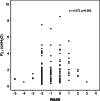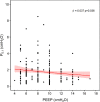Clinical risk factors for increased respiratory drive in intubated hypoxemic patients
- PMID: 37041553
- PMCID: PMC10088111
- DOI: 10.1186/s13054-023-04402-z
Clinical risk factors for increased respiratory drive in intubated hypoxemic patients
Abstract
Background: There is very limited evidence identifying factors that increase respiratory drive in hypoxemic intubated patients. Most physiological determinants of respiratory drive cannot be directly assessed at the bedside (e.g., neural inputs from chemo- or mechano-receptors), but clinical risk factors commonly measured in intubated patients could be correlated with increased drive. We aimed to identify clinical risk factors independently associated with increased respiratory drive in intubated hypoxemic patients.
Methods: We analyzed the physiological dataset from a multicenter trial on intubated hypoxemic patients on pressure support (PS). Patients with simultaneous assessment of the inspiratory drop in airway pressure at 0.1-s during an occlusion (P0.1) and risk factors for increased respiratory drive on day 1 were included. We evaluated the independent correlation of the following clinical risk factors for increased drive with P0.1: severity of lung injury (unilateral vs. bilateral pulmonary infiltrates, PaO2/FiO2, ventilatory ratio); arterial blood gases (PaO2, PaCO2 and pHa); sedation (RASS score and drug type); SOFA score; arterial lactate; ventilation settings (PEEP, level of PS, addition of sigh breaths).
Results: Two-hundred seventeen patients were included. Clinical risk factors independently correlated with higher P0.1 were bilateral infiltrates (increase ratio [IR] 1.233, 95%CI 1.047-1.451, p = 0.012); lower PaO2/FiO2 (IR 0.998, 95%CI 0.997-0.999, p = 0.004); higher ventilatory ratio (IR 1.538, 95%CI 1.267-1.867, p < 0.001); lower pHa (IR 0.104, 95%CI 0.024-0.464, p = 0.003). Higher PEEP was correlated with lower P0.1 (IR 0.951, 95%CI 0.921-0.982, p = 0.002), while sedation depth and drugs were not associated with P0.1.
Conclusions: Independent clinical risk factors for higher respiratory drive in intubated hypoxemic patients include the extent of lung edema and of ventilation-perfusion mismatch, lower pHa, and lower PEEP, while sedation strategy does not affect drive. These data underline the multifactorial nature of increased respiratory drive.
Keywords: Acute respiratory failure; Positive end-expiratory pressure; Respiratory drive; Risk factors.
© 2023. The Author(s).
Conflict of interest statement
PN received personal fees for lectures from Fisher and Paykel, Mindray, Hamilton, outside of the submitted work. TM received personal fees for lectures from Drager, Mindray and Fisher and Paykel, outside of the submitted work. All other authors declare that they have no competing interests.
Figures




Similar articles
-
[Effect of positive end expiratory pressure level selection in prone position ventilation on lung recruitment and inflammatory factors in patients with severe acute respiratory distress syndrome].Zhonghua Wei Zhong Bing Ji Jiu Yi Xue. 2020 Jun;32(6):702-706. doi: 10.3760/cma.j.cn121430-20200406-00290. Zhonghua Wei Zhong Bing Ji Jiu Yi Xue. 2020. PMID: 32684216 Clinical Trial. Chinese.
-
Non-invasive ventilatory support and high-flow nasal oxygen as first-line treatment of acute hypoxemic respiratory failure and ARDS.Intensive Care Med. 2021 Aug;47(8):851-866. doi: 10.1007/s00134-021-06459-2. Epub 2021 Jul 7. Intensive Care Med. 2021. PMID: 34232336 Free PMC article. Review.
-
Sigh improves gas exchange and lung volume in patients with acute respiratory distress syndrome undergoing pressure support ventilation.Anesthesiology. 2002 Apr;96(4):788-94. doi: 10.1097/00000542-200204000-00004. Anesthesiology. 2002. PMID: 11964584
-
Effects of Sigh on Regional Lung Strain and Ventilation Heterogeneity in Acute Respiratory Failure Patients Undergoing Assisted Mechanical Ventilation.Crit Care Med. 2015 Sep;43(9):1823-31. doi: 10.1097/CCM.0000000000001083. Crit Care Med. 2015. PMID: 25985386 Clinical Trial.
-
Patient self-inflicted lung injury: implications for acute hypoxemic respiratory failure and ARDS patients on non-invasive support.Minerva Anestesiol. 2019 Sep;85(9):1014-1023. doi: 10.23736/S0375-9393.19.13418-9. Epub 2019 Mar 12. Minerva Anestesiol. 2019. PMID: 30871304 Review.
Cited by
-
Controlled Mechanical Ventilation in Critically Ill Patients and the Potential Role of Venous Bagging in Acute Kidney Injury.J Clin Med. 2024 Mar 5;13(5):1504. doi: 10.3390/jcm13051504. J Clin Med. 2024. PMID: 38592687 Free PMC article.
-
Clinical and Experimental Evidence for Patient Self-Inflicted Lung Injury (P-SILI) and Bedside Monitoring.J Clin Med. 2024 Jul 10;13(14):4018. doi: 10.3390/jcm13144018. J Clin Med. 2024. PMID: 39064059 Free PMC article. Review.
-
Understanding cardiopulmonary interactions through esophageal pressure monitoring.Front Physiol. 2023 Jul 19;14:1221829. doi: 10.3389/fphys.2023.1221829. eCollection 2023. Front Physiol. 2023. PMID: 37538376 Free PMC article. Review.
-
Personalized positive end-expiratory pressure in spontaneously breathing patients with acute respiratory distress syndrome by simultaneous electrical impedance tomography and transpulmonary pressure monitoring: a randomized crossover trial.Intensive Care Med. 2024 Dec;50(12):2125-2137. doi: 10.1007/s00134-024-07695-y. Epub 2024 Nov 11. Intensive Care Med. 2024. PMID: 39527121 Free PMC article. Clinical Trial.
-
Airway and Transpulmonary Driving Pressure by End-Inspiratory Holds During Pressure Support Ventilation.Respir Care. 2023 Nov;68(11):1483-1492. doi: 10.4187/respcare.10802. Epub 2023 Jul 18. Respir Care. 2023. PMID: 37463722 Free PMC article.
References
-
- Bruce EN, Cherniack NS. Central chemoreceptors. J Appl Physiol. 1985;1987(62):389–402. - PubMed

